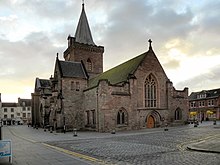
Perth is a centrally located Scottish city, on the banks of the River Tay. It is the administrative centre of Perth and Kinross council area and is the historic county town of Perthshire. It had a population of about 47,430 in 2018.

St Giles' Cathedral, or the High Kirk of Edinburgh, is a parish church of the Church of Scotland in the Old Town of Edinburgh. The current building was begun in the 14th century and extended until the early 16th century; significant alterations were undertaken in the 19th and 20th centuries, including the addition of the Thistle Chapel. St Giles' is closely associated with many events and figures in Scottish history, including John Knox, who served as the church's minister after the Scottish Reformation.

The Grote Kerk or St.-Bavokerk is a Reformed Protestant church and former Catholic cathedral located on the central market square in the Dutch city of Haarlem. Another Haarlem church called the Cathedral of Saint Bavo now serves as the main cathedral for the Roman Catholic Diocese of Haarlem-Amsterdam.
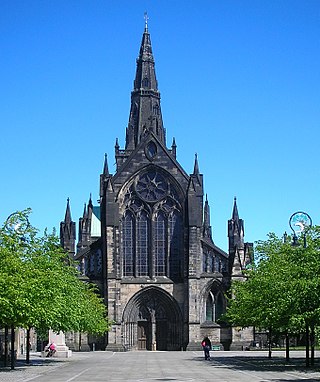
Glasgow Cathedral is a parish church of the Church of Scotland in Glasgow, Scotland. It is the oldest cathedral in mainland Scotland and the oldest building in Glasgow. The cathedral was the seat of the Archbishop of Glasgow, and the mother church of the Archdiocese of Glasgow and the Province of Glasgow, until the Scottish Reformation in the 16th century. Glasgow Cathedral and St Magnus Cathedral in Orkney are the only medieval cathedrals in Scotland to have survived the Reformation virtually intact. The medieval Bishop's Castle stood to the west of the cathedral until 1789. Although notionally it lies within the Townhead area of the city, the Cathedral grounds and the neighboring Necropolis are considered to be their own district within the city.

Abernethy is a village and former burgh in the Perth and Kinross council area and historic county of Perthshire, in the east central Lowlands of Scotland.

Alyth is a town in Perth and Kinross, Scotland, five miles northeast of Blairgowrie and about 17 miles northwest of Dundee. In 2016 the town had an estimated population of 2,400.

Dunkeld is a town in Perth and Kinross, Scotland. The location of a historic cathedral, it lies on the north bank of the River Tay, opposite Birnam. Dunkeld lies close to the geological Highland Boundary Fault, and is frequently described as the "Gateway to the Highlands" due to its position on the main road and rail lines north. Dunkeld has a railway station, Dunkeld & Birnam, on the Highland Main Line, and is about 25 kilometres north of Perth on what is now the A9 road. The main road formerly ran through the town, however following modernisation of this road it now passes to the west of Dunkeld.

Kirk in the Hills Presbyterian (1958) is a church located in Bloomfield Township, Michigan.
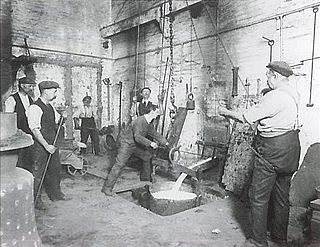
Gillett & Johnston was a clockmaker and bell foundry based in Croydon, England from 1844 until 1957. Between 1844 and 1950, over 14,000 tower clocks were made at the works. The company's most successful and prominent period of activity as a bellfounder was in the 1920s and 1930s, when it was responsible for supplying many important bells and carillons for sites across Britain and around the world.
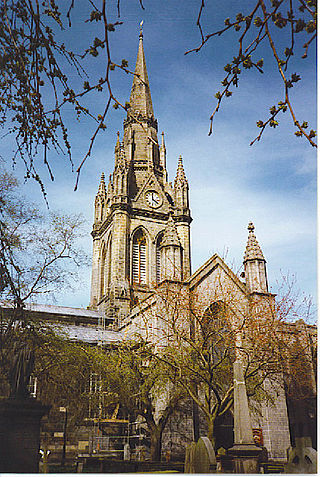
The Kirk of St Nicholas is a historic church located in the city centre of Aberdeen, Scotland. Up until the dissolution of the congregation on 31 December 2020, it was known as the "Kirk of St Nicholas Uniting". It is also known as "The Mither Kirk" of the city. As of 1 January 2021, the building falls under the care and maintenance of the General Trustees of the Church of Scotland.
Vanden Gheyn, Van den Gheyn or Van den Ghein was a family of bellfounders and carillon makers. The bell foundry was established in 1506 in Mechelen and active until the 20th century. They have been called "the most famous family of bellfounders [Belgium] has had".
Perth is a city and former royal burgh in central Scotland. There has been a settlement at Perth since prehistoric times. Finds in and around Perth show that it was occupied by the Mesolithic hunter-gatherers who arrived in the area more than 8,000 years ago. Nearby Neolithic standing stones and circles followed the introduction of farming from about 4000 BC, and a remarkably well preserved Bronze Age log boat dated to around 1000 BC was found in the mudflats of the River Tay at Carpow to the east of Perth. Carpow was also the site of a Roman legionary fortress.

Portmoak is a parish in Kinross-shire, Scotland. It consists of a group of settlements running north to south: Glenlomond, Wester Balgedie, Easter Balgedie, Kinnesswood, Kilmagadwood and Scotlandwell.

Stobo Kirk is an ancient church of the Church of Scotland. It is dedicated to St Mungo and is situated near the B712 off the A72 just 6 miles south-west of Peebles in the ancient county of Peeblesshire, now part of the Scottish Borders Council area.

Rhynd is a hamlet in Perth and Kinross, Scotland. It is located 3+1⁄4 miles southeast of Perth, on the south side of the River Tay.
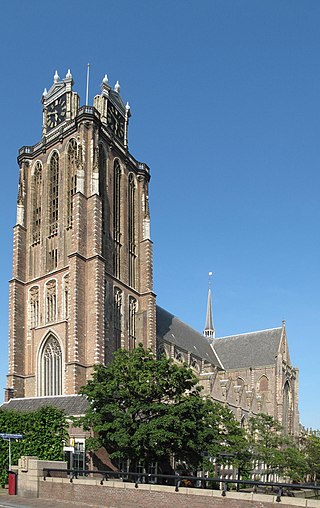
The Grote Kerk of Dordrecht, officially the Church of Our Lady is a large church in the Brabantine Gothic style, and the largest church in the city. It was built between 1284 and 1470, though some parts are newer. It became a Protestant church in 1572, and remains an active church, now owned by the Protestant Church in the Netherlands.

John Halkerston was a Scottish architect, prominent in the 15th century. He was Master of Works at Trinity College Kirk, Edinburgh, in the 1460s. Around the same time, he worked on St John's Kirk, in Perth, the northwest porch of which is now named "Halkerston Tower" in his honour. The door of the tower is known as the "Bride's Entrance" due to its use during weddings today.

St Paul's Church is a former church building located in Perth, Perth and Kinross, Scotland. Standing in St Paul's Square, on the Old High Street, at its junction with South Methven Street, it was completed in 1807. The work of architect John Paterson, it is now a Category B listed building. It was one of the first churches to be built in Perth after the Reformation, sparked by John Knox's sermon at the nearby St John's Kirk in 1559.

Crieff Town Hall is a municipal building in the High Street, Crieff, Perth and Kinross, Scotland. The structure, which is currently used as a tourist information centre and museum, is a Category B listed building.
